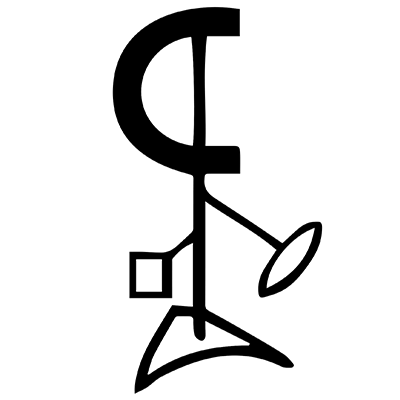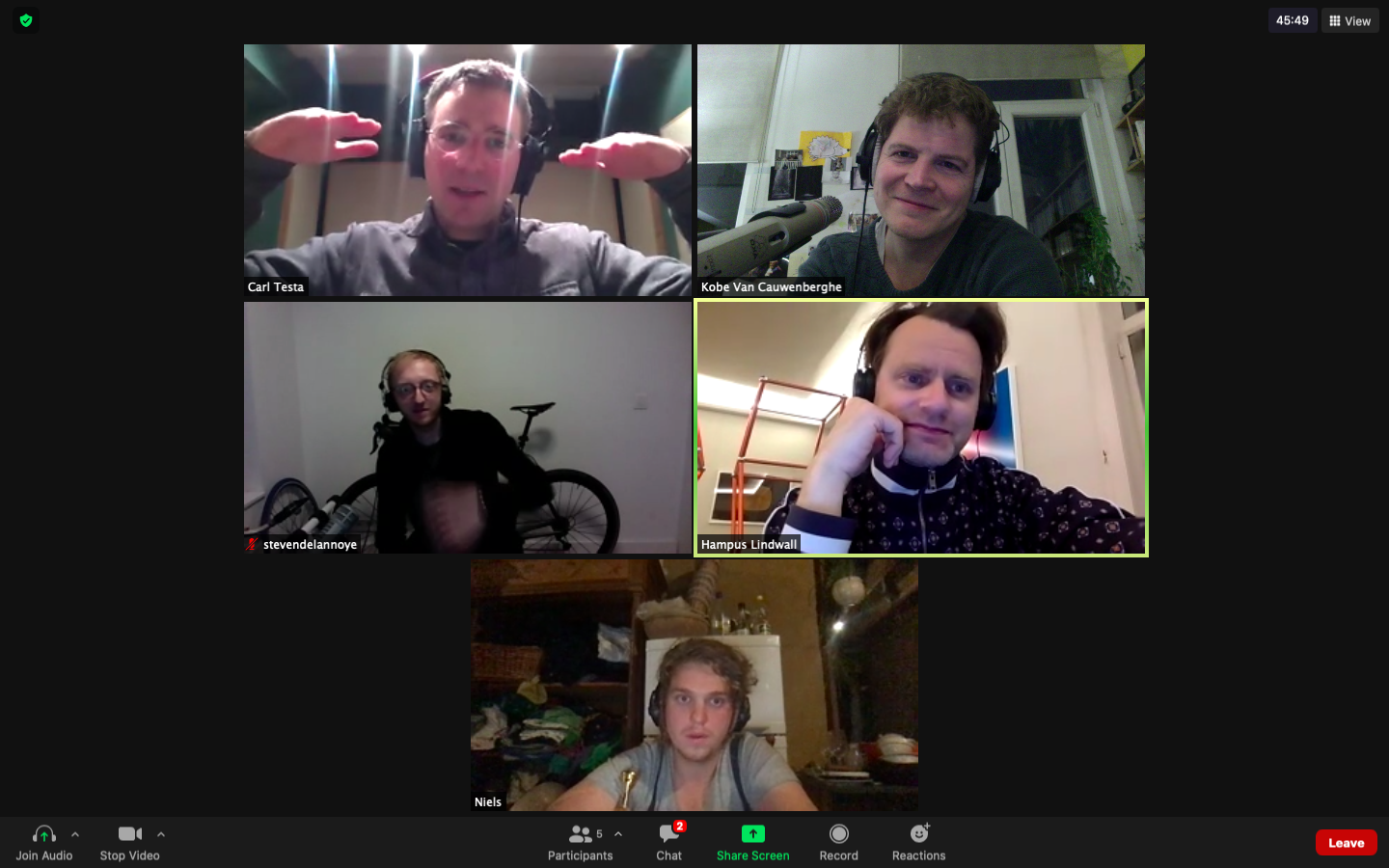Carl Testa and Kobe Van Cauwenberghe on Echo Echo Mirror House Music
Transatlantic Echo Echo Mirror House performance led by Kobe Van Cauwenberghe and Carl Testa on February 1, 2021.
I first experienced Anthony Braxton’s Echo Echo Mirror House Music (EEMHM) in concert at Wesleyan University in Spring 2009. Braxton had 20-30 musicians onstage each with an iPod and the sound was probably the densest sound I’d heard up to that point. (This was prior to me listening to all the notes of an organ played at once in 2011).
My first experience performing in EEMHM came in Fall 2010 with a septet performance in Strasbourg, France. For this performance I had come up with some ideas as to how to relate to the change state cues from Anthony and in the score by changing parameters of my effects pedals, but was still overall completely lost as far as “finding myself” in the music due to the density of musical information coming from every direction. I had to let the experience wash over me and just focus on the experience of it rather than trying to make something happen.
This experience had an almost subliminal effect on me and my music-making. I found myself drawn to trying to make sense of the density and that experience, and my own compositional interests shifted slightly to researching dense, layered sound environments like those found in my 2015 duo CD with guitarist Christopher Riggs, Sⁿ.
In 2015, I started to work on solving the problem of replacing the use of iPods in EEMHM with a central computer system using SuperCollider that would enable musicians to join and leave the collage on demand from any web-connected device. The system was fully functional by 2016 and I was able to demo it for Braxton. He gave me crucial feedback on certain elements that would be required for it to fully replace the iPods such as the ability to drill down and select a specific piece and not just random pieces.
In 2017, I had the opportunity to bring the EEMHM to the Experimental Media and Performing Arts Center (EMPAC) as part of their Spatial Audio Workshop. For this workshop I was able to prototype a spatial system of EEMHM where compositions in the collage could be placed in a specific physical place in a concert hall via EMPAC’s Wavefield Synthesis System. The musicians or audience could physically walk through the collage and hear different pieces jumping into their head as they traversed from one side of the concert hall to the next.
In 2019, I finally had the opportunity to present a version of the new EEMHM system in performance with pianist Cory Smythe for a performance at Roulette in NYC. For that performance, 8 speakers surrounded the audience and the collage varied over the course of the performance from 2 - 60 layers of recorded sound collaged with Braxton solo piano music and graphic scores used for controlling live processing.
The telematic performance in Antwerp of EEMHM is the latest iteration of the development of the new EEMHM system that combines the updated web-based controller system with the higher-level control processes used in the 2019 performance. This system involves the creation of a remote server located in Amsterdam that runs the EEMHM software and receives control signals from the web-based controller. The audio is then transmitted to Antwerp into the performance space using audio networking software SonoBus. There are numerous options for continued development. These include increasing the spatialization of the collage via Ambisonics and/or Wavefield Synthesis. Opening the collage up to involve audience members or virtual audience members so that they can directly influence the spectrum of the collage. Increasing the categorization of sounds in the EEMHM system is another area for growth where instead of only grouping compositions by composition type (solo, opera, Ghost Trance Music) one could group compositions and performances by Braxton’s Language Music parameters and use Machine Learning to group similar sounds together so that orchestration with recorded sound in performance becomes an improvisational resource. Braxton has laid the foundations for such a rich musical resource that I believe we’ll continue to find fresh insights into the Echo Echo Mirror House music for years to come.
Carl Testa
February 4, 2021
My interest in EEMHM was triggered by reading Carl’s insightful overview of the EEMHM system in Sound American's Anthony Braxton Issue. I was especially intrigued by how EEMHM fits into Braxton's overall musical philosophy as well as its unexplored possibilities; how, instead of iPods, a web-based interface could be used to control the overall sound collage, allowing people from all over the world to potentially join in. I had already been exploring quite a bit of Braxton’s music as part of an ongoing research project, mostly focussing on Ghost Trance Music and some of the older compositions. When I received the opportunity to present something for the Articulate Research Days at the Antwerp Conservatory last fall, I thought this could be a great occasion to try out one of the EEMHM compositions in a multinational version using Carl’s web-based controller.
Carl and I started with a few test sessions in October 2020 to check if the software worked, and if the EEMHM sound collage and my live-playing could travel back and forth between New Haven and Brussels without too much trouble. We used JackTrip and SonoBus software to have high quality sound with minimal latency, with Carl controlling the collage and me playing guitar. It immediately worked really well. Unfortunately the planned public performance in November in Antwerp was canceled due to a second wave of Covid-19 infections in Belgium, but since the system was functioning between Carl and myself, we decided to continue more online test sessions, with musicians joining in from our homes in Brussels, Antwerp and New Haven. This proved to be a little more complicated, but we did manage to play a first version of Composition 381 where five players were virtually connected, playing music together. Then, on February 1, we got a second chance to do an actual public performance via live-stream at the conservatory in Antwerp. For this version, we were five musicians playing live in Antwerp with Carl giving conducting cues from his home in New Haven, and all of us connected to the EEMHM web-based controller, sending sound via a server in Amsterdam.
Carl's skillful approach with the technology and his patience in helping me and the other musicians getting familiar with both the technical set up and the multilayered graphic scores and different cueing strategies of Braxton's EEMHM, was incredibly helpful. The current health crisis also had an impact on how we worked: it certainly made evident the visionary aspects and potential of the EEMHM system as a way to continue exploring new ways of playing together. But pandemic and technical innovation aside, it is the profound poetic implications of the EEMHM system that still fascinates me the most. How Braxton associates EEMHM with "Sound Mass Logics", as one of the ways to realize his holistic vision of sonic unification, connecting his entire oeuvre and philosophy in the same event-space and to be able to hear in one instant the depth and richness of his compositional output. This concept of having past-present and future in the same time-space, of dealing with time in a non-linear way, to me seems unprecedented in a musical situation. It is present on every level of the EEMHM system, in the multilayered graphic scores, the cueing strategies, the interaction with the sound collage, but it also gave me a deeper understanding of older systems like Ghost Trance Music and where it fits into Braxton’s holistic philosophy.
Although often elusive and hard to grasp at first, something that made it easier for me to get a better sense of Braxton's ideas and terminology was to look for similar concepts in SciFi literature. There's a striking parallel between the concept of EEMHM and the way the creatures of the planet Tralfamador in Kurt Vonnegut's Sci-Fi classic "Slaughterhouse Five" experience time in a non-linear way. They are "unbound by the normal limitations of time and space", and so for them the universe, for example, does not look like a lot of bright little dots. "[They] can see where each star has been and where it is going, so that the heavens are filled with rarefied, luminous spaghetti." When they read books they read them all at once. "What we love in our books are the depths of many marvelous moments seen all at one time." I would think the Tralfamadorians would very much dig EEMHM too.
A next step in exploring the possibilities of the EEMHM system could be to develop a surround sound version of EEMHM. In the version we performed we only used stereo, but Carl already has done a multi-speaker set up in the past. It would be interesting to see how "ambisonics" technology could push the EEMHM system to an even more immersive level and have this translated to a binaural headphone mix for everyone to tune in wherever they are. I can see how this can develop towards both a physical and virtual sound-installation that can function like a live-event with musicians interacting with the scores and the collage in the physical or virtual space, or as a standalone installation where the audience can walk in and out and control the collage with their cell-phones while walking through it.
Kobe Van Cauwenberghe
February 4, 2021




